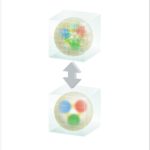As nuclear physicists delve ever deeper into the heart of matter, they require the tools to reveal the next layer of nature’s secrets. Nowhere is that more true than in computational nuclear physics. A new research effort led by theorists at DOE’s Jefferson Lab is now preparing for the next big leap forward in their studies thanks to funding under the 2017 SciDAC Awards for Computational Nuclear Physics.
Supercomputing Subatomic Particle Research on Titan
By using multiple grids and separating the modes in the problem onto the various grids most efficiently, the researchers can get through their long line of calculations quicker and easier. “GPUs provide a lot of memory bandwidth,” Clark said. “Solving LQCD problems computationally is almost always memory-bound, so if you can describe your problem in such a way that GPUs can get maximum use of their memory bandwidth, QCD calculations will go a lot quicker.” In other words memory bandwidth is like a roadway in that having more lanes helps keep vehicles moving and lessens the potential for traffic backups.”





